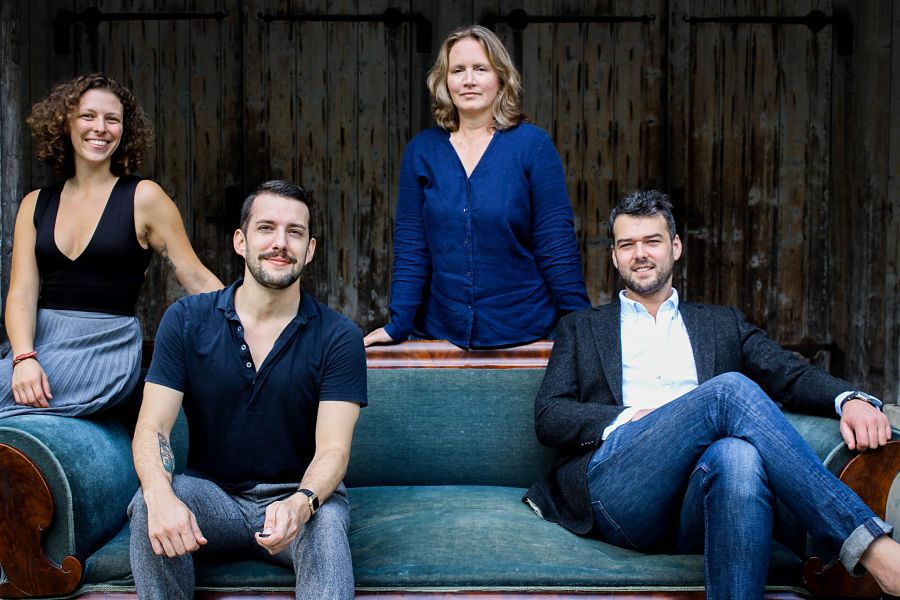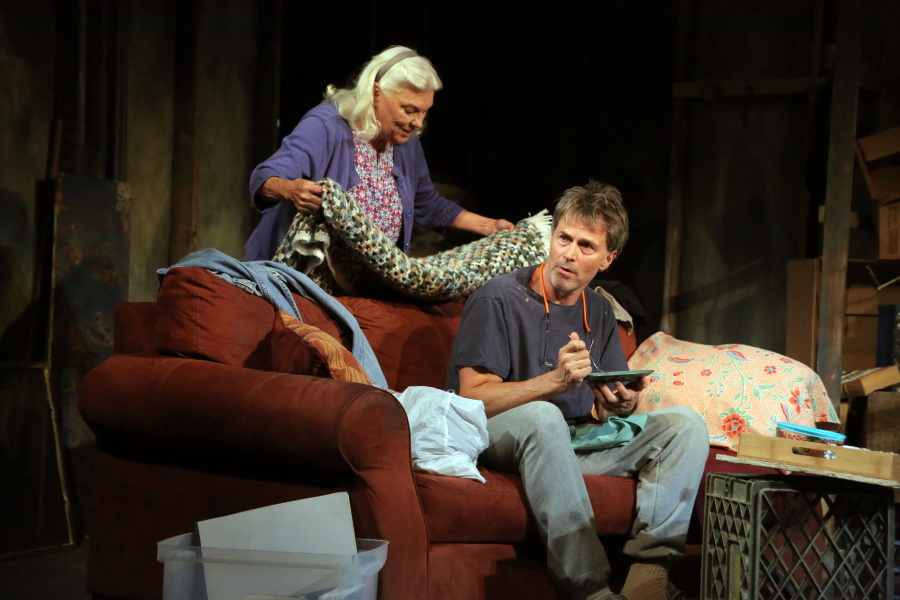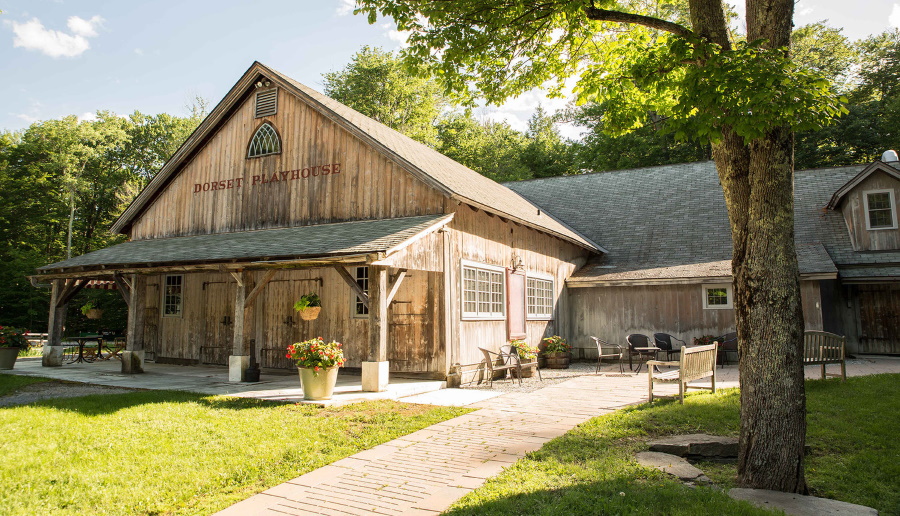DORSET, VT.: This tiny town in Vermont’s southwest corner (pop.: 2,031), named after an English county, is famous as the site of Cephas Kent’s Tavern, an important meeting place for the iconoclasts who founded the independent Vermont Republic, and later the state. You can also find America’s oldest marble quarry here, as well as the birthplace of William Griffith Wilson (Bill W. of Alcoholics Anonymous fame).
About a block away from the town’s main drag is the woodsy Dorset Playhouse building, built 90 years ago, and seating 295. If the outside looks like a bit like a barn, that’s not far off: As artistic director Dina Janis told us recently, the venue—home of the summer-long Dorset Theatre Festival—is made, essentially, of barn parts.
Who founded Dorset Theatre Festival, when, and why?
On July 2, 1929, the Dorset Playhouse officially opened. In typical Vermont style, the building of this lovely theatre was a true community effort and included the use of three local barns in its construction. Since the 1930s, the Playhouse has served as a home to many, including the members of Fred and Pat Carmichael’s beloved Caravan Theatre, a wonderful year-round community theatre (the Dorset Players), and, since the 1970s, the Dorset Theatre Festival, a professional summer theatre founded by Jill Charles and John Nassivera. Under the passionate and energetic artistic leadership of Jill and John, the festival flourished for many decades as a launchpad for new playwrights, a training ground for new talent, and a home for a truly beloved group of theatre professionals who helped make DTF the fixture it became for 38 years.
Since 2001 and a $3 million restoration to the building, Dorset Theatre Festival continues to thrive and prosper. John Nassivera took over the reins after the death of the irreplaceable Jill Charles. Carl Forsman and the acclaimed Keen Company ran the festival from 2007 to 2009, and in 2010 I became the artistic director.

Tell us about yourself and your connection to the company.
I grew up in Chicago and moved to New York in my late teens, studying acting with Stella Adler, Uta Hagen, and my primary teacher, Kim Stanley. I worked for many years as an actor, became a member of the Actors Studio, and began directing in my early 30s. In 2010, the festival had lost its leadership, its audience base, and its footing. At that time, I had been living in Vermont working as a professor of drama at Bennington College. Playwright Theresa Rebeck and I had used the playhouse during some of our playwrights retreats, which were a collaboration with the Lark in New York. The board knew of my work and approached me about taking the reins at that time. With encouragement from many of my N.Y. professional colleagues, I jumped into the opportunity of rescuing and reinventing a future for the festival and helping to move it forward into its second act.
What sets your theatre apart from others in your region?
Our programming sets us apart, in that from the very beginning we featured new work, bringing to the region world premieres and regional premieres by some of the top playwrights working today. This approach has brought many top artists to our stages—folks like Theresa Rebeck, Stephen Adly Guirgis, Judd Hirsch, Alfre Woodard, Estelle Parsons, Treat Williams, Jayne Atkinson, Michael Cristofer, Tim Daly, and Tyne Daly, among others. We hire a lot of women in top leadership roles, including some amazing directors, such as Giovanna Sardelli, Jade King Carroll, Adrienne Campbell-Holt, Jackson Gay, Pirronne Yousefzadeh, Jenn Thompson, Evan Yionoulis, and Margarett Perry, to name a few. We have been recognized for our commitment to supporting and producing female playwrights. Our New Play Development Retreat Programs, Women Artists Writing Group (WAW), and our popular Pipeline Series have also helped in establishing us a top new-play incubator in the country. Our audience definitely feels ownership of this, and that has been exciting.
We also have a deep belief that theatre should belong to everyone, and have, from the very beginning, patterned ourselves off of the Public Theater in New York City by instituting our Giving Back Program, underwriting free tickets each year to several communities in the region, including farmers, first responders, military families, people with special needs, and other volunteer groups. This initiative has transformed the audience we had in many important ways, creating a more regional, rather than solely local, patron base, a more economically diverse audience, and building a sense of vibrancy and engagement over the past 10 years.
What are the challenges of producing theatre in Dorset?
First, our location has its challenges, being just that tiny bit further away than the culturally thriving region of the Berkshires. Though we now are regularly reviewed by critics from Albany’s Capital District and the Berkshires, we have yet to break the glass ceiling of the NYC or Boston critics for the most part, which can be frustrating, given the level of work we are producing. Doing cutting-edge work in this region has meant a strong commitment on our part to community engagement and outreach, which requires creative strategizing in order to encourage people who may not normally consider themselves theatregoers to give the experience a try.
Economically, the region is extremely stratified. There are very wealthy second-home owners from NYC and Boston and a large number of summer tourists co-existing with the people who live and work here year-round and often struggle to stay afloat. We are fortunate now to have found great support for our new-play programs from national funders, but the local economy struggles to support its major arts organizations generally, which means that we are still very much dependent upon box office revenue to keep our doors open. With our commitment to presenting new work, which is sometimes provocative and often does not have name recognition, we have had to work hard at developing an audience base that trusts us and feels a part of the exciting community we have built.

Tell us about your favorite theatre institution other than your own, and why you admire it.
Gosh, that is such a hard question. I admire so many of my colleagues, some of whom are part of producing organizations and some running developmental organizations. I have long been inspired by the Public Theater. Their commitment to democratic values, to being inclusive, to taking risks in their programming, to supporting artists of color and women, and to making sure that folks of all stripes and economic status have access to the work they do, has always been a standard bearer for me. Regionally, Steppenwolf stands out, and I say this with fondness, having been on the ground as a high school classmate when my peers Gary Sinise and Jeff Perry started that company. In terms of nurturing the deserving and diverse voices of today, you can’t beat the Lark in many ways. John Clinton Eisner has had an impact that will be felt for decades. I think we have entered a moment now when so many women and people of color have taken over the reins of some of the most influential theatres in the country—there has been a real turnover, and I am looking forward to an era of leadership that reflects these changes in terms of programming and equity.
How do you pick the plays you put on your stage?
First, I have my own taste and aesthetic, I suppose, which influences me on a profound level. I have a deep love and respect for playwrights, and am moved by those who speak with an authentic voice and have something important to say. I tend to love things that are a bit dark…that is who I am, I suppose. Beyond my own artistic leanings, I am also committed to really listening to the audience itself, balancing the need to gently push their boundaries while at the same time respecting them. I am fortunate to have so many playwrights, actors, and directors who regularly come to me with material they are excited by, and this is extremely helpful to me on many levels. Financially, I am committed to continuing to take bold risks each season, while making sure we are bringing our audience along with us and listening deeply to their responses to our programming.
What’s your annual budget, and how many artists do you employ each season?
Our annual budget is now about $925,000, and this year we have employed 72 artists, not including year-round or seasonal staff and apprentices.
What show are you working on now? Anything else in your season that you’re especially looking forward to?
We just opened our world premiere of Theresa Rebeck’s stunning new play, Dig, which received an Edgerton Foundation New Play Award, and which was particularly rewarding due to the amazing collaboration between Theresa, who’s also directing the play, and her design team, which included Tony-winning sound designer Fitz Patton, Christopher and Justin Swader on scenic design, Tilly Grimes on costumes, Philip Rosenberg on lighting design, and a truly top-notch cast. We are in rehearsal now for our second world premiere of the season, Mrs. Christie, by Heidi Armbruster. This play, which we are proud to have developed through our Women Artists Writing Group, of which Heidi is a founding member, is a kind of feminist take on the 10-day disappearance of Agatha Christie, structured in two simultaneous time periods, Arcadia-style. I like to think of it as a combination of Agatha Christie and “Fleabag.” It is brilliant, highly entertaining, and destined to be a huge hit. Heidi has a unique voice for our times—full of wit, sharp, and deeply human.
What’s the strangest or funniest thing you’ve ever seen (or put) on your stage?
Well, we generally feature some pretty great comedies on our stage, so it’s hard to pick favorites. But one that always stands out to me, for many reasons, was our brilliant production of what is, in some ways, the funniest play of all time and a love letter to the theatre, Noises Off by Michael Frayn, directed by the amazing Jenn Thompson.
What are you doing when you’re not doing theatre?
I teach at Bennington College, which keeps me inspired. I love to read, hang out with my husband and kids at home, walk my dog, and take a swim.
What does theatre—not just your theatre, but the American or world theatre—look like in, say, 20 years?
I am hopeful that the theatre in general will be a place which has served to uphold democratic principles during times in which these very principles are under attack all over the world, and of course in this country in particular. I look forward to women and people of color having equal representation in every area of theatre, at the management level, board level, and artistic and technical levels. I am hopeful that the theatre will continue to find ways to make sure that it remains for the people and of the people and does not become increasingly irrelevant or elitist, while at the same time not pandering to commercial pressures. I think we have a huge responsibility to lead the way in standing up for human values and rights, and demonstrating what civil discourse looks like. We can entertain, we can be teachers, we can listen, we can respond to these times, we can exist as a refuge for many, we can provoke change, we can inspire. I hope that we do.


